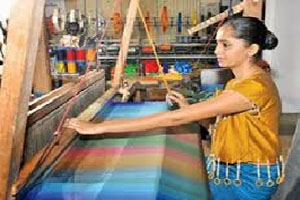
Sri Lankan handlooms set to flourish again
YarnsandFibers News Bureau 2017-01-28 15:00:00 – ColomboSri Lankan handloom runs through 3000 years of history, rich heritage and cultural diversity, even today its handloom products passes down diversity, uniqueness and ingenuity in their designs and technologies. The traditions of weaving and handloom manufacturing still holds strong among the Sri Lankan handloom weavers who still stand faithful to the age-old designs of weaving that have been handed down through generations.
Today, there are over 10,000 Sri Lankan handloom manufacturers clustered in the Western, Central, Eastern, Southern and Northern provinces of Sri Lanka. Many of the Sri Lankan handloom manufacturers are home- based small holders or individuals employed by private, cooperative and government agencies which are mainly catering to a growing export market.
Made with cotton and silk materials of brilliant colours, Sri Lankan handloom designs and products are used extensively by leading fashion designer and interior decorators in creating new fashion statements and interior decoration trends with handloom curtains, kitchen and dining linen, rugs and bed linen that are sold under leading labels across the world.
Minister of Industry and Commerce Rishad Bathiudeen addressing the launch of the National Handloom Exhibition ‘Ransalu’ at the BMICH in Colombo on Friday said that Sri Lanka is enlisting its surging tourism and provincial cottage infrastructure to transform its struggling handloom produce to global markets and a national blueprint for this transformation is now ready. Sri Lanka’s handloom industry formerly had 200,000 people but today this has fallen to 10,000.
The cottage level industry produces export quality designs and material. A great number of producers are of small and micro level. The leading province in handloom production is the Western Province followed by the Eastern province and the Central province.
To develop Sri Lanka’s handloom sector back to its former levels, the Ministry of Industry and Commerce has set up a Handlooms Industry Task Force which is focusing on tourism as well, the Minister said.
Although the use of handlooms were strictly restricted to cotton handloom sarees and home linens among Sri Lankan consumers, a new generation of Sri Lankan designers are seeking to revive the face and future of the Sri Lankan handloom industry by combining old designs with bold colours, textures and material.
Today, a range of new handloom designs and products by a number of leading handloom manufacturers including bold coloured handloom garments, handloom bridal sarees made with silk and polished cotton, vibrant handloom kaftans, sarongs and shawls, hand woven tapestries and rugs have become the toast of the town around the world.
Many tourists to Sri Lanka make a shopping tour of the leading handloom outlets in the country in search of the best bargains while regional fashion weeks frequently feature designs made with Sri Lankan handloom designs.
With an increased demand for environmentally sustainable and handmade products made by Fair Trade labour Sri Lankan handloom industry holds a greater opportunity for global expansion.
The Sri Lanka’s handloom textile industry is highly labour-intensive, export-oriented, rural based and has the capability to generate high returns if the right product is offered at the right place at the right price. It has also gained high socio economic importance due to the significant employment generating potential especially among the rural women in Sri Lanka.
The manufacturing process includes scouring (removing waxes, oil and dirt marks) and bleaching, dyeing, washing, hydro extracting the material which is then sized again put through the process of hydro extraction and dyeing.
The mix of manufacturers includes leading handloom weaving manufacturers as well as small scale producers. With the help of factories, some small scale weavers have been given an opportunity to showcase their talents and penetrate international markets.
Leading producers have not only found success but also present their wares to tourists to Sri Lanka, which has always resulted in an excellent response. A range of designs and colours are on offer. Individual and innovative designs, craftsmanship, colour combination and patterns are handed down from generation to generation.
Italy, Germany, France, UK, Norway, Netherlands and Maldives markets are some of the largest buyers of Sri Lankan handloom textile products. Sri Lankan handloom producers are capable of supplying numerous products which are designed for niche markets where handmade products of high value are preferred.
In 2014 Sri Lanka exported nearly US$ 1.09 million worth of handloom products including garments, upholstery fabric and curtaining, handloom bags, soft toys and hand woven rugs and tapestries to countries including Maldives, South Korea, UK, Sweden, Australia, Netherlands, Spain and USA.
Market Intelligence
Ask for free sample Report

experience
Customer Base
dedicated team
Countries Served Worldwide









